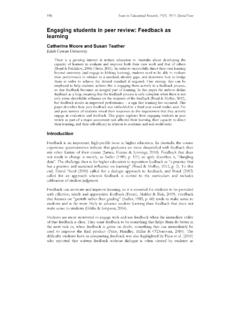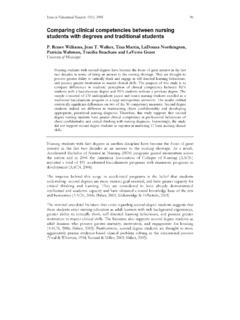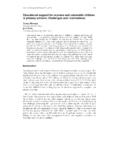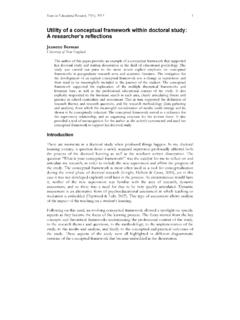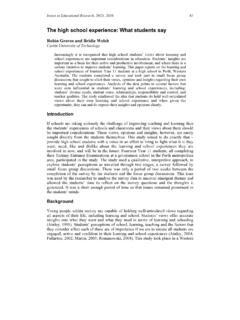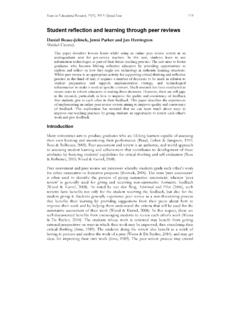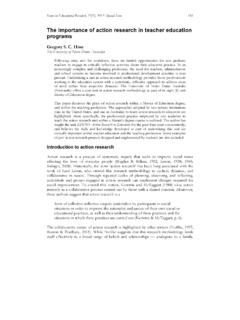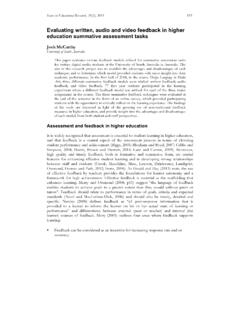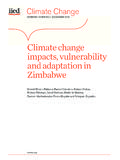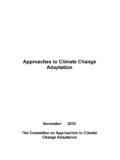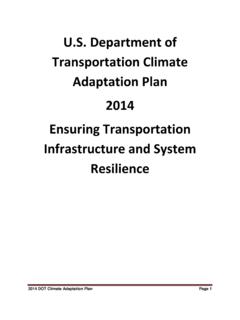Transcription of Teacher adaptation to open learning spaces
1 Issues in Educational Research, 23(3), 2013 315 Teacher adaptation to open learning spaces Scott Alterator and Craig Deed La Trobe University The open classroom emerged as a reaction against the industrial-era enclosed and authoritarian classroom. Although contemporary school architecture continues to incorporate and express ideas of openness, more research is needed about how teachers adapt to new and different built contexts. Our purpose is to identify Teacher reaction to the affordances of open space learning environments. We outline a case study of Teacher perceptions of working in new open plan school buildings. The case study demonstrates that affordances of open space classrooms include flexibility, visibility and scrutiny, and a de-emphasis of authority; Teacher reactions included collective practice, team orientation, and increased interactions and a democratisation of authority. We argue that Teacher reaction to the new open classroom features adaptability, intensification of day-to-day practice, and intra- and inter-personal knowledge and skills.
2 Opening up the classroom The insular classroom, based on a modularised cost-effective design, emerged during the 1800s, and was usually characterised by an authoritarian and transmissive mode of education (Rabinowitz, 1974). In his classic account of school buildings in the 1800s, Barnard (1848, p. 32) described a typical cramped school house: "School houses are not usually larger than twenty by twenty-four feet on the ground, and seven feet in height .. Not unfrequently sixty or seventy .. scholars occupy a room of this size." Barnard's description of a constrained cellular space is consistent with Bataille's (in Hollier, 1990, p. 7) writing of the "architectural straitjacket" of buildings that imposed a mixed sense of servitude, awe, order, and constraint on people. We find similar sentiment in Hatton's (1999, pp. 66-67) comment that architecture primarily "advantages alienation" and "its conditions appear to be those of definition/distinction, confinement/separation".
3 Over previous decades educational theorists have provided numerous critiques, refinements and variations of the dominant industrial-era school model (see Gislason, 2007; Upitis, 2004). These attempts to understand physical space and how it dynamically represents, communicates and shapes learning behaviours and routines continue to influence school architecture and teaching practice (Melhuish, 2011). The term " open classroom" gained currency during the 1960s and into the 1970s, although experimentation with the use of open space can be traced to Dewey (United States of America) and Freinet (Europe) in the early 20th century (Sivell, 1994). The open classroom originated, and continues to evolve, as a multi-disciplinary reaction against perceptions of alienation, authoritarian control, restrictiveness, and stability of conventional classrooms and schools (Gulson & Symes, 2007).
4 It generally referred to "a style of teaching involving flexibility of space , student choice of activity, richness of learning materials, integration of curriculum areas, and more individual or small-group rather than large-group instruction" (Horwitz, 1979, pp. 72-73). 316 Teacher adaptation to open learning spaces Contemporary school architecture in the Western world frequently incorporates the open classroom concept (Melhuish, 2011; Nair & Fielding, 2005). New learning spaces are realised through the design of large open plan buildings and the use of virtual learning space , combining to formally afford more flexible educational practices (Leiringer & Cardellino, 2011). These educative spaces are non-hierarchical, multi-functional, integrate physical and virtual space , and authorise student control over approaches to learning (Melhuish, 2011). They are not definitively physically or conceptually separate from traditional school space , although there is sufficient dislocation for "questioning, and the possibility of a restructuring, of the hitherto stable boundaries between formal/informal, Teacher /student, classroom/home" (Usher, 2002, p.)
5 53). Our purpose is to identify Teacher reaction to the affordances of open space learning environments. We consider how modern architectural versions of the open classroom authorise different approaches to teaching. A case study is outlined of teachers reacting to working in a space largely undone from prior versions of traditional school buildings. A dynamic balance of convention and experimentation emerges as teachers adapt to the built affordances of their new school building. The study of how teachers respond to uncertainty and adapt to new learning spaces can inform ongoing research about effective pedagogy and school design (Clark, 1988; Boys, 2011). Affordances of new learning spaces Building design can create an impression, or be symbolic, of the type of learning environment likely to be experienced (Gislason, 2007; Halpin, 2007; Tanner, 2000; Upitis, 2004). Gislason (2007, p. 6) noted that built spaces "offer a kind of signifying field for human activity, helping to give it an immediate and grounded direction".
6 The intentions of an open plan building are not just an expression of an abstract idea, but seek to shape the practical actions and thinking of teachers and students (Halpin, 2007). An open learning environment, physically expressed as a building larger than four conventional classrooms, may initially appear as an empty non-school space . On entry, Teacher memories of practice and routine are likely to unravel, or at least be challenged. The openness of the space affords breaking from institutional traditions and flexible use of space and time. For teachers and students this may afford a rethinking of teaching and learning . The resulting activity is a function of how the inhabitants of the space perceive the affordances and constraints of the learning environment. Affordances refer to those aspects of an environment that enable, contribute to, or constrain the kinds of interaction that subsequently occur (Greeno, 1994).
7 The affordances of a context must be perceived by an individual who must also have the abilities to interact with these attributes. Although openness can disrupt teaching conventions, it is the social activity of the inhabitants that define the possibilities of a learning space (Lefebvre, 1991). Alterator & Deed 317 Previous studies have acknowledged the complex nature of learning environments (Leiringer & Cardellino, 2011. Gislason, 2010). This complexity creates difficulty in establishing causal links between physical environments and learning outcomes (Higgins, Hall, McCaughey, Wall, & Woolner, 2005). Similar to the finished beginnings characterising school designs in Barrett and Zhang (2009, p. iv), Leiringer and Cardellino (2011) noted that the school is not completed when the building is. Moreover, Leiringer and Cardellino (2011) acknowledged the fallacious claim that buildings will lead necessarily to improved educational outcomes.
8 Essentially, the causal relationship can be characterised as contributory as distinct from necessary or sufficient. Furthermore, Higgins et al. (2005, p. 6) warn against architectural determinism when considering learning environments. Particular difficulty is encountered when attempting to assess the impact of learning environments on student performance. A review of the available literature by Higgins et al. (2005) indicated a tendency to separate school environments into components. They concluded that there is consistent evidence for the effect of basic physical variables (air quality, temperature, noise) on learning (p. 7). Higgins et al. (2005) also noted that less significant effects are evident once basic standards have been achieved. Hattie s (2009) review of meta-studies indicated little to no impact from open plan environments. Hattie (2009, p.)
9 89) concluded that factors such as open space and team teaching are not factors in distinguishing effective from less effective open education programs . Hattie (2009) acknowledged an impact on non-achievement outcomes that did not correlate to academic achievement. Welch (2000) and Jang (2006) examined Teacher practice related to open plan learning environments. While each acknowledged limited capacity to generalise due to lack of a control group and the qualitative framework of the research, their findings are more promising than Hattie indicates (each demonstrated improved student outcomes as a result of varying team teaching initiatives). Furthermore, a meta-analysis by Martin and Pavan (1976) concluded that despite a lack of independent variables for assessing initiatives arising from open plan spaces , the overall impact of open plan environments are not to the detriment of student progression.
10 The potential limitations of research in identifying student achievement improvements due to open plan environments are acknowledged. However, we acknowledge the interactions of different elements are as important as the consideration of single elements (Higgins et al., p. 22) and focus on observing emergent behaviour of teachers as they interact with the architecture of the open classroom. Teacher knowledge and open space The take-up of the affordances of new learning spaces depends on teachers identifying and using this potential (Woolner, Hall, Higgins, McCaughey, & Wall, 2007). It is the purposeful linking of different theoretical, disciplinary and practical perspectives of openness which can result in a workable realisation of contextual affordances of flexible learning spaces (Blackmore, Bateman, Loughlin, O'Mara, & Aranda, 2011; Boys, 2011). 318 Teacher adaptation to open learning spaces The Teacher s thinking and practice, their engagement with the multiple perspectives about effective learning environments and related pedagogy, is a key influence in the effective use of learning space (Davis, Leach, & Clegg, 2011; Temple, 2007).
